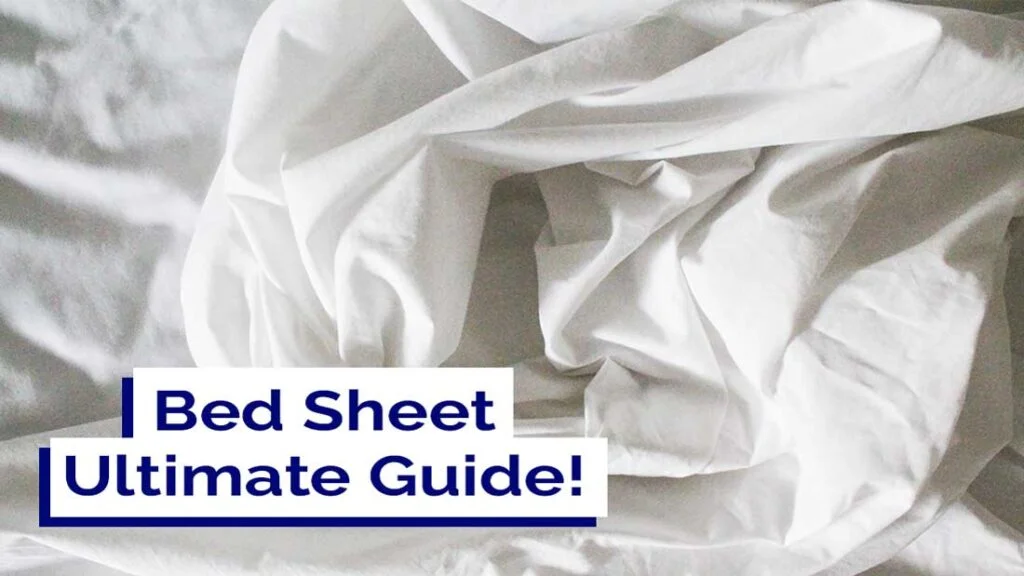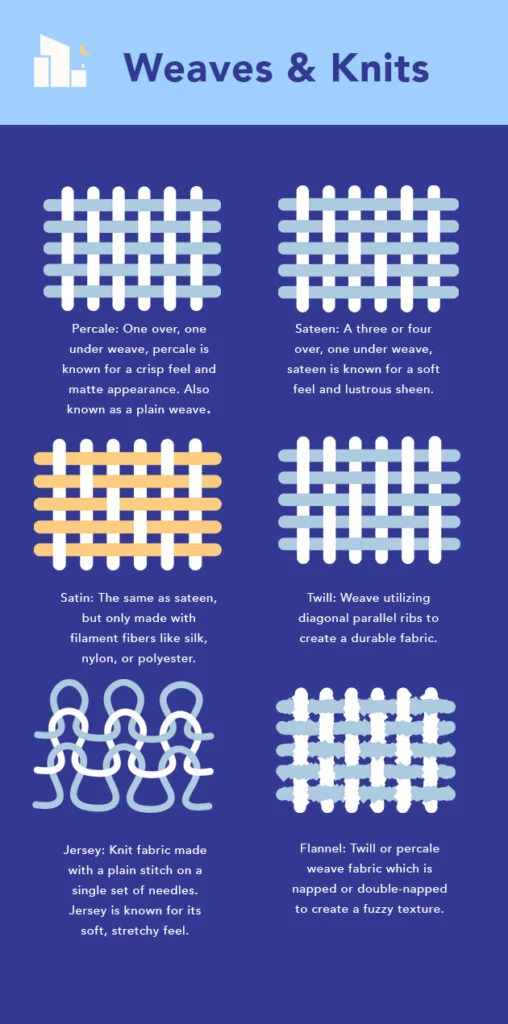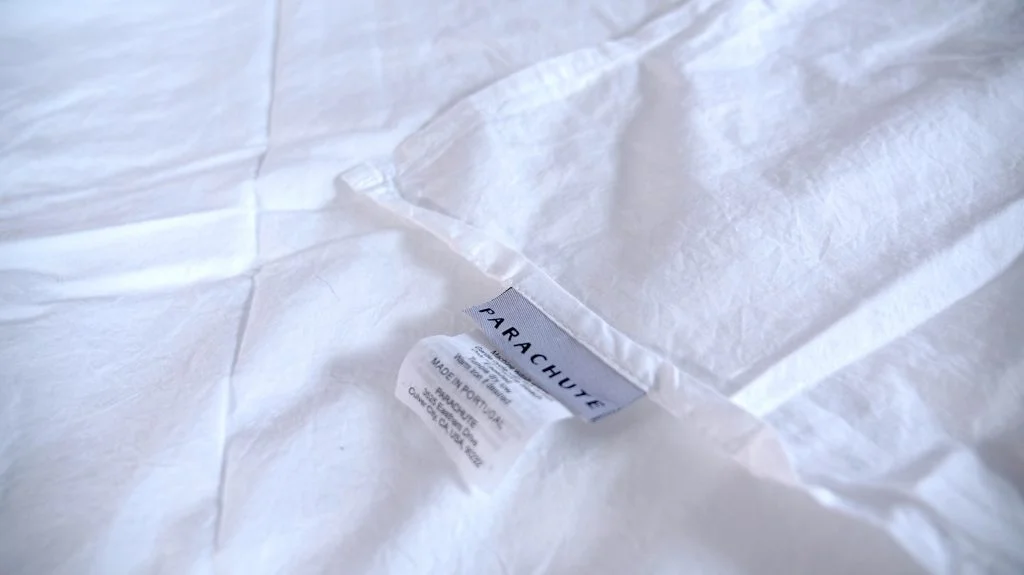
There are a lot of different types of sheets — a LOT. If you are shopping for a new set and starting to research online, it is easy to become overwhelmed. What is the best material for sheets? How do different materials feel? How can you tell if sheets are worth the price? All these questions and more can arise if you are just dipping your toe into the world of sheets.
To help simplify your search, we have compiled the ultimate guide to bed sheets. We have tested tons of sheets here at Sleepopolis (check out our favorites on our best sheets page!) and we are bringing that hands-on knowledge to you.
Read on to learn about the different types of sheets, how to choose the right sheets for you, and some frequently asked questions.
Short on time? Go ahead and check our quick detailed in-depth video breakdown between linen and cotton sheets.
Our Sheet-Buying Guide Video
What Are The Different Types of Sheets?
The most important thing to know about sheets is what they are made of. Materials will tell you a lot about how sheets will feel, their cooling and breathability, and their durability, as well as help you gauge if the price is fair.
The two things to consider when looking at a sheet set are 1) the material it is made with and 2) the weave or knit style. Materials are the fibers — raw materials not formed into fabric — and weave or knit as the form of construction used to make the fiber into a cloth. The same material can feel different depending on the weave or knit style, and the same weave or knit style can feel different depending on the material.
Materials
Let’s first go over some of the most common materials used to make sheets.

Cotton: Cotton is one of the most popular materials for sheets, either used by itself or in a blended fabric (meaning it contains two or more materials). Cotton is a natural, fluffy fiber that grows on the cotton plant. It is highly valued for being durable, breathable, and soft.
There are different varieties of cotton, as well as different quality levels. Two of the highest quality cottons are Egyptian and Pima/Supima cotton. Egyptian cotton is grown in Egypt, as the name suggests. Pima cotton is grown in the United States, although you might often see it referred to as “Supima,” as well. This is a portmanteau of “superior pima” and is a registered trademark of the Supima trade association, which promotes Pima cotton.
These two varieties of cotton are valued for their long staples, or fibers. Long staples are desirable because they are less likely to pill, hold the structure of the weave better, and overall lead to a softer, more durable sheet. If a fabric is made with short staple cotton, it is common for the staples to start to poke out over time, leading to a decrease in the softness and comfort.
However, there are lower quality cottons used in sheet making as well. Upland cotton is one of the most common. Because of its lower quality, it is often cheaper than Egyptian or Pima/Supima cotton. Additionally, organic cotton of any variety is generally more expensive than non-organic cottons.
See our best cotton sheets.

Bamboo: Bamboo is an increasingly popular material for sheets and other bedding. It is a synthetic material made from the pulp of bamboo. To create this fabric, the bamboo can either be physically mashed into pulp or chemically processed. In either process, the cellulose of the bamboo is extracted, spun into thread, and then woven into fabric. This type of fabric is known as a viscose or rayon and can be made with a wide variety of source materials aside from bamboo.
Bamboo viscose is popular because it is soft, smooth, silky, temperature-regulating, and moisture-wicking. It is also often popularly cited as an environmentally-friendly material. This is because bamboo is a relatively sustainable plant to grow, because it grows quickly, doesn’t require much irrigation or intense cultivation, and doesn’t require chemical pesticides or fertilizers. Bamboo also absorbs more carbon and produces more oxygen than other similar plants.
However, the process of turning bamboo into viscose fabric requires the use of acidic or toxic chemicals, as well as using large amounts of water, dyes, and finishing chemicals. This is important to note because this processing does have a negative environmental impact, even though there are many positives to bamboo as a sustainable material.
See our best bamboo sheets.

Tencel: Tencel is a similar material to bamboo viscose. However, it is made from eucalyptus instead of bamboo and uses a slightly different manufacturing process. Tencel is actually a brand name — the generic term for this material is eucalyptus lyocell.
Lyocell is similar to viscose in that it is a regenerated cellulose fabric, but is made with a more eco-friendly process. The U.S. Federal Trade Commission defines lyocell as rayons “composed of cellulose precipitated from an organic solution in which no substitution of the hydroxyl groups takes place and no chemical intermediates are formed” — essentially meaning it does not use the harmful chemical solvents normal viscoses use. Lyocell production also results in little waste product, but it is still relatively energy intensive.
Like bamboo viscose, Tencel provides a soft, silky, smooth, and cool feel — hence why it is a popular bedding material.
Polyester: Polyester is a fabric most people are familiar with, due to its common use in clothing. Polyester is a synthetic material and a form of plastic, making it generally inexpensive and extremely durable. It is also usually moisture-wicking, which can be a pro to hot sleepers.
However, polyester isn’t generally a highly-prized material for bedding because it isn’t as soft or breathable as other materials. Pure polyester sheets are likely to feel somewhat scratchy or low quality. However, polyester is commonly used in fabric blends with natural materials like cotton, which can make them more affordable.
Silk: Silk is a natural protein fiber, produced by insects to form their cocoons. Silk can be produced by a number of different insects, but the most commonly used is silk from the mulberry silkworm. The fiber produced by these insects is harvested, unwound, and twisted together to form yarn, which can be used to make fabric.
Silk production dates back far in human history and has long been regarded as a luxury fabric. It is a strong, durable material that is also lusciously soft and shiny. Silk is also very breathable, because it is a natural material, and generally maintains a cool temperature. This makes it a popular choice for hot sleepers. Additionally, silk can be beneficial for hair and skin, as it won’t absorb moisture or cause hair breakage like other materials, since it is so smooth.
Unlike other woven fabrics, silk isn’t measured by thread count, but by momme. Momme is a Japanese unit of weight measurement. A higher momme means a thicker/heavier silk, which also can indicate quality level.
Because silk is an animal product, there are some ethical questions about its production. Some oppose use of the material because the silkworms are generally killed to harvest the fibers.
See our best silk sheets.

Linen: Linen is a fabric woven from flax fibers, which come from the flowering flax plant, also known as linseed. Linen is one of the oldest fabrics — possibly dating back as far as 30,000 years ago in human history. This traditional fabric is highly valued for its durability, breathability, and pleasantly textured feel.
As a natural fiber like cotton, linen offers excellent breathability. However, linen is even more breathable than cotton, because the fibers themselves are more hollow, meaning air can flow through more easily. Plus, it usually helps that most linen fabrics have a lower thread count — and thus looser weave — than most cotton fabrics.
Linen can be a fairly expensive material, so expect to see higher prices than you would for cotton. Some brands blend linen with other materials to make it more affordable, so be sure to look for 100 percent linen, if that is what you’re after.
See our best linen sheets.

Weaves and Knits
Now that we’ve covered some common materials, let’s go over different weave and knit styles. Remember, sheets made with different weave or knit styles can feel and perform drastically differently — even if they are made from the same material.

Percale: Percale is one of the most commonly used weaves for sheets. Also sometimes known as a plain weave, percale is a one yarn over, one yarn under weave. That means the warp (lengthwise threads) and weft (horizontal threads) will be equal in number.
Percale is characterized by a crisp, smooth feel and a matte appearance. This weave is also valued for its breathability, as it has a lower thread count than other styles.
See our best cotton percale sheets.

Sateen: Sateen is another common weave style, using a three or four yarn over, one yarn under weave. This means the fabric is usually thicker and more tightly woven than percale — often with a higher thread count, too. Sateen is known for its lustrous sheen, soft and smooth feel, and beautiful drape. It also tends to be warmer than percale, due to being thicker.
See our best sateen sheets.

Satin: Satin is an extremely similar weave to sateen — in fact, it’s basically the same thing. Satin also uses a three or four over, one under weave. However, the difference lies in the materials used to create the weave. Satin is made exclusively with filament fibers, while sateen is made with staple fibers.
What are filament fibers? Some of the most common ones used for satin are silk, nylon, and polyester. Traditionally, satin was only made with silk but modern materials like nylon and polyester are now used, too. Staple fibers include materials like cotton and rayon, which are used for sateen.
Twill: Twill is a style of weave which uses diagonal parallel ribs, which are created by passing the weft thread over one or more warp threads and then passing it under two or more warp threads. This creates a visual diagonal line pattern on the fabric, as well as making the fabric sturdy and drape nicely.
One of the most common applications of twill is to create denim, but it is also used in sheets and other bedding. Twill tends to have a higher thread count, which also makes it a warmer fabric.
Flannel: Flannel is a material most people are likely familiar with from flannel shirts, but it is also a material used for bedding. Traditionally only made with wool, flannel is now made with a variety of materials. Cotton and polyester are the most common.
Flannel is generally made with either a twill or percale weave. The fabric is then napped to hide the weave. Napping is a finishing technique that gives flannel that signature fluffy, fuzzy feel. Flannel can be napped on just one side, or it can be double-napped, meaning both sides of the fabric are napped, for extra softness. Flannel is also often sheared after napping for a smoother texture.
Prized for its warmth, flannel is primarily popular as a winter material. You can assess how thick and heavy a flannel sheet is by the GSM, or grams per square meter. A GSM of 130 to 135 is considered lightweight, 140 to 150 is considered midweight, and 160 or more is considered heavyweight.
See our best flannel sheets.

Jersey: Jersey is a common knit fabric used for sheets. Known for its soft, stretchy feel, jersey is also very easy to care for. This makes it especially popular for kids’ bedding. Jersey is commonly described as having a “T-shirt material feel,” which makes sense since most T-shirts are cotton jersey knit!
Traditionally, jersey was primarily made with wool but is now commonly made with wool, cotton, and polyester. Jersey is generally knit with a plain stitch on a single set of needles, with all the loops facing the same direction.
See our best jersey sheets.

How To Choose The Right Sheets For Your Bed
Now that you have a better understanding of the different materials, as well as weave and knit styles, used to make sheets, let’s talk about how to decide what type of sheet is best for you.
Keep in mind that you may want to invest in different sheets for different purposes — for example if you live somewhere that can be both very cold and very hot, you might want separate summer and winter sheets.
Materials
As discussed above, there are many different materials used to make sheets. Each material has its own unique properties, as well as its own pros and cons. It’s important to consider what you want from your sheets as you decide on a material. Do you value softness the most? Breathability and cooling? Durability? Ease of care? Determine what characteristics you want from your sheets and start narrowing down which materials will fit those needs best.
Fit

Finding sheets that fit your bed is generally pretty easy — if you have a queen size bed, you’ll want to buy queen size sheets. Unless you have a non-standard bed, this is basically how it goes.
However, the one aspect of fit you may want to consider is pocket depth. Fitted sheets can vary in how deep the pockets are, since mattress heights are not standardized like length and width. If your mattress is more than 10 inches tall, you may want to consider looking specifically for deep-pocket fitted sheets. We recommend the pockets be a few inches larger than the height of your bed — if your bed is 15 inches tall, look for 16 to 17 inch pockets.
Color and Pattern

One of the most fun parts of sheet shopping is choosing color and pattern. If you have a specific aesthetic or interior design vision in mind, that’s something important to consider as you shop. Not all brands carry a wide variety of colors and patterns, so you may want to start your search with brands that do if that is important to you.
Most bedding brands will offer sheets in a classic white, as well as a few other neutral options like gray, cream, or beige. Others commonly include pastel colors or other mass appeal shades. Very few brands offer lots of bold colors or patterns, but there are some. Brooklinen is a great brand to consider if you love color — they offer fun and funky limited edition colors and patterns for almost all their bedding.
Thread Count
Thread count is another important factor, but not in the way it is popularly conceived. The common knowledge about thread count is that higher is always better, but that’s not always true. In fact, brands selling sheets with astronomically high thread counts in the thousands are usually fudging the numbers with double-ply threads or other sly methods.
A higher thread count simply means there are more threads per square inch, but what is a good thread count depends on the style of the sheet. For example, good quality percale sheets usually have a thread count of 180 to 300, whereas good quality sateen usually have a thread count of 300 to 600. This is because sateen requires more threads, due to the weave style, than percale does.
Plus, some fabrics don’t even use thread count as a measure, such as silk, jersey, or flannel.
Learn more about thread count in our guide to the best thread count for sheets.
Cooling
If you are on the hunt for cooling sheets, there are two main types of fabrics that will be beneficial to you: sheets that are breathable or sheets that are temperature-regulating.
Natural fibers like cotton, linen, or silk are all very breathable, meaning it is easy for air to flow through them. This makes them popular among hot sleepers, as they won’t trap too much heat. (Be sure to choose a lower thread count cotton sheet, like a percale sheet, to promote cooling.)
Other fabrics like bamboo, Tencel, or other semi-synthetics are temperature-regulating, meaning they maintain a naturally cooler temperature and adjust with your body temperature. These are fantastic for keeping cool when it’s hot — especially because they are often moisture-wicking, too.
See our best cooling sheets.
Care Instructions

Different materials will require different methods of washing and drying. Some are more involved than others, so it’s worth looking into the required care instructions for bedding before purchasing. For example, silk sheets may require special detergent and often must be hand washed or line dried. The same can be true for other delicate materials.
Price
As with any purchase, price is an important factor to consider. Sheets can vary quite widely in price, depending on the materials, quality of construction, the brand, and so on. It’s good to have an idea of your budget before you start shopping so you can narrow your options.
For queen size sheets, expect to pay anywhere between $50 and $300, depending on the style of sheets. In general, materials like linen and silk will be the most expensive. Cotton, bamboo, Tencel, or other similar materials can vary — some are quite expensive, while others are more affordable. Polyester and other synthetic fabrics will generally be the least expensive.
See our best sheets for the money.
Bed Sheets FAQs
What’s the best thread count for sheets?
There is no single best thread count for sheets — it actually depends a lot on the style of the sheet. Learn more in our thread count guide.
How often do you need to change your bed sheets?
It is best to change your bed sheets once a week, to ensure allergens and bacteria aren’t building up in your bedding. Learn more in our guide on how often to wash sheets.
What types of sheets are best for hot sleepers?
The best sheets for hot sleepers include cotton percale, bamboo, linen, silk, and Tencel.
What sheet pocket size do I need?
We recommend the pocket of your fitted sheet be at least a few inches larger than the height of your bed.


























